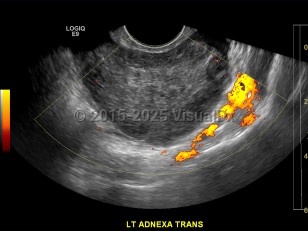Emergency: requires immediate attention
Ovarian torsion
Alerts and Notices
Important News & Links
Synopsis

Ovarian torsion is an acute condition that can be a true gynecologic emergency. It occurs when an ovary twists on the adjacent infundibulopelvic ligament, causing disruption of blood supply to the ovary and in effect creating a tourniquet. Torsion accounts for 2.7% of all gynecologic emergencies. It is more common in women 20-30 years of age, but it can occur at any age from early childhood (rare) to after menopause. Ovarian torsion more commonly occurs on the right side.
Patients present in various manners, making this a challenge to diagnose in an emergency setting. The most classic presentation is a sudden onset of sharp / stabbing pain in either the right or left lower quadrant that only lasts a few seconds to a few minutes and then resolves to a dull ache, only to recur at various intervals with sharp / stabbing pains for a short amount of time. This presentation is associated more with partial or intermittent torsion. Patients also commonly present with a gradual onset of more colicky, unimpressive-type pain. Often patients will also complain of nausea / vomiting when pain occurs.
Abdominal examination may reveal positive rebound and guarding or may be more benign if the ovary is not acutely torsed at time of examination.
Risk factors include ovarian cyst with size greater than 4-6 cm or with solid components, history of prior torsion, pregnancy, and history of pelvic surgery. Patients may not have had a history of ovarian cysts prior.
Patients present in various manners, making this a challenge to diagnose in an emergency setting. The most classic presentation is a sudden onset of sharp / stabbing pain in either the right or left lower quadrant that only lasts a few seconds to a few minutes and then resolves to a dull ache, only to recur at various intervals with sharp / stabbing pains for a short amount of time. This presentation is associated more with partial or intermittent torsion. Patients also commonly present with a gradual onset of more colicky, unimpressive-type pain. Often patients will also complain of nausea / vomiting when pain occurs.
Abdominal examination may reveal positive rebound and guarding or may be more benign if the ovary is not acutely torsed at time of examination.
Risk factors include ovarian cyst with size greater than 4-6 cm or with solid components, history of prior torsion, pregnancy, and history of pelvic surgery. Patients may not have had a history of ovarian cysts prior.
Codes
ICD10CM:
N83.519 – Torsion of ovary and ovarian pedicle, unspecified side
SNOMEDCT:
13595002 – Torsion of ovary
N83.519 – Torsion of ovary and ovarian pedicle, unspecified side
SNOMEDCT:
13595002 – Torsion of ovary
Look For
Subscription Required
Diagnostic Pearls
Subscription Required
Differential Diagnosis & Pitfalls

To perform a comparison, select diagnoses from the classic differential
Subscription Required
Best Tests
Subscription Required
Management Pearls
Subscription Required
Therapy
Subscription Required
References
Subscription Required
Last Reviewed:04/10/2017
Last Updated:03/01/2020
Last Updated:03/01/2020
Emergency: requires immediate attention
Ovarian torsion

